Handling Different Fever Temperatures in Babies
Exploring the Basics of Fever: What is it and How Can it be Treated?
Exploring the Idea of a Fever-Free Weekend
The regulation of body temperature is primarily governed by the hypothalamus, a region within the brain. This critical function involves a delicate balance between heat production by the muscles and liver and heat dissipation through the skin and lungs.
Fever is a physiological response in which the body’s temperature is increased, mediated by the hypothalamus. It is typically triggered by the immune system as a defense mechanism against infectious agents, such as bacteria or viruses.

Investigating the Impact of Fever on Children
When a fever occurs, the body’s immune system becomes more active, stimulating the immune response and eliminating disease-causing antigens.
It has been observed that administering vaccinations to children is associated with reduced effectiveness when the child is also taking fever-reducing medication for a fever. This can result in a weakened immune response in the child.
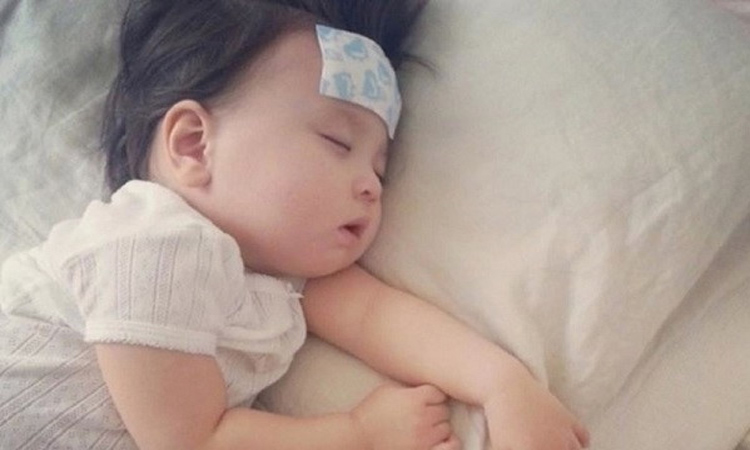
Fever significantly impacts the body, manifesting in various ways. Elevated body temperature raises the likelihood of hypersensitivity reactions and the occurrence of shock. It also intensifies lysis, resulting in a reduction of zinc and iron levels within the bloodstream.
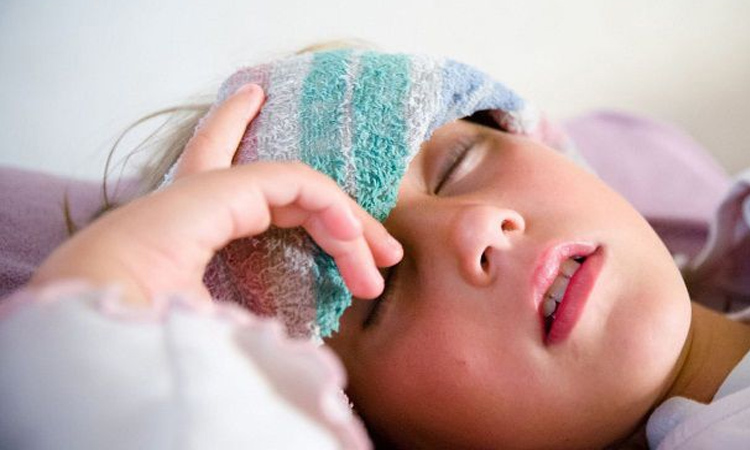
Fever not only leads to dehydration and electrolyte imbalances, but it also poses serious risks for children and infants, including convulsions and neurological damage. Individuals with high fever may suffer from additional harmful effects, such as delirium, confusion, exhaustion, fatigue, heart failure, and respiratory failure.
Recognizing the Signs of a Fever
When the body temperature is elevated by 1°C or higher than the normal body temperature, it is known as a fever. A fever is typically indicated by a temperature over 38 degrees Celsius when measured in the anus or mouth, or over 37.5 degrees Celsius when measured in the armpit.
According to experts, a newborn is considered to have a mild fever if their body temperature fluctuates between an average of 37.5 – 38 degrees Celsius.
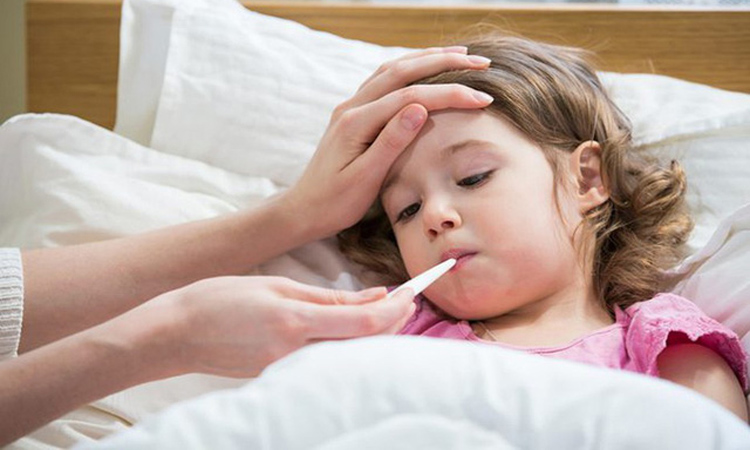
If a child has a high fever exceeding 38-39 degrees Celsius, it is important for the mother to take immediate measures to reduce the fever. In cases where the child’s fever reaches up to 40 degrees Celsius and is accompanied by symptoms of convulsions, it is crucial for the mother to seek prompt medical examination and treatment for the baby by taking them to the hospital.
Using a Thermometer to Check a Child’s Temperature
Typically, rectal temperature measurement is regarded as the most accurate method. Consequently, parents should opt for this method instead, as it is more commonly used and considered safer. It is important to note that mercury, which is commonly found in thermometers, poses a significant health risk. In the event that a mercury thermometer breaks, it can be particularly dangerous for young children.
Please find below the various methods for measuring body temperature in children:
Take Armpit Temperature Readings to Check for Fever
- Ensure that the child’s armpit is dry before taking measurements.
- Please instruct your child to hold the thermometer by pressing their elbow to their chest for approximately 4-5 minutes.
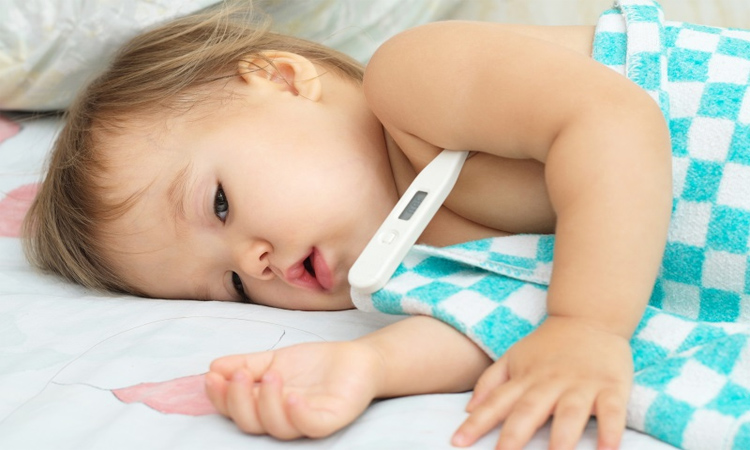
Take Oral Temperature Measurements
This method should not be performed when the child has consumed hot food or drink within the last 30 minutes. Parents should follow these steps:
- Clean the thermometer thoroughly by washing it with cold water and soap, followed by rinsing it with clean water.
- To accurately measure the child’s temperature, carefully position the thermometer tip under their tongue. Instruct the child to securely hold the thermometer with their lips, ensuring their lips remain closed around the thermometer for the duration of the measurement.
- To ensure accuracy, it is important to properly use a thermometer. When using a mercury thermometer, children should hold it for approximately 3 minutes. However, when using an electronic thermometer, children only need to hold it for less than 1 minute. This will provide an accurate temperature reading.
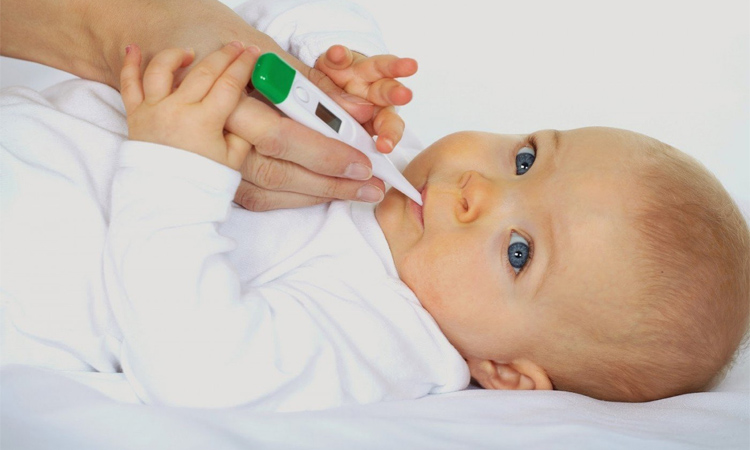
Checking Body Temperature with an Ear Thermometer
This method is not suitable for children under 6 months old. If your child has recently been outside in the cold, it is recommended to wait for at least 15 minutes before taking their temperature. The display of the child’s body temperature is not affected by ear canal or ear disease. Please follow these steps to measure the temperature:
- Prior to inserting the thermometer, gently pull on the child’s outer ear.
- Please place the thermometer probe in your ear for a duration of 2 seconds.

At-Home Device for Measuring Rectal Body Temperature
- To ensure the safety and comfort of infants and young children, it is recommended for them to lie face down in the lap of a responsible adult. This position provides support and security for the child during moments of rest or relaxation.
- To ensure accurate readings, it is recommended to lightly apply a small amount of lubricant, such as vaseline, to the end of the thermometer.
- Please carefully insert the thermometer into the child’s anus until the silver tip is no longer visible, reaching a depth of approximately 0.6 – 1.3cm.
- Please ensure that the thermometer remains stationary while waiting. Allow approximately 2 minutes for a mercury thermometer and 1 minute for an electronic thermometer.
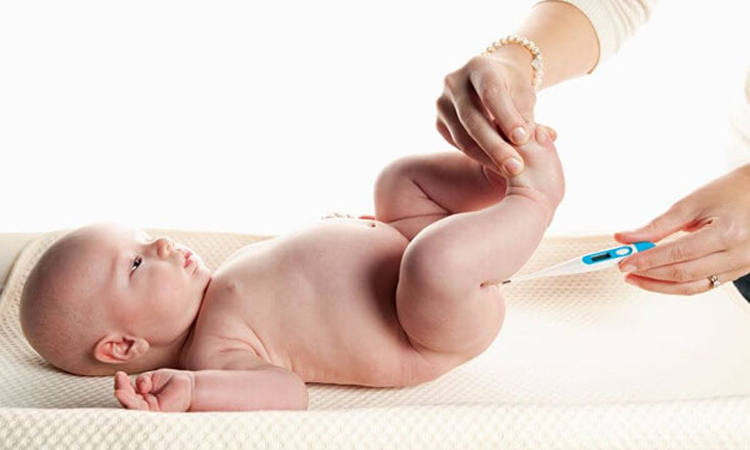
How to Manage 3 Levels of Fever in Children
The normal temperature of a child is typically between 36.5 degrees Celsius and 37.2 degrees Celsius when measured under the armpit.
Newborns are prone to hypothermia, even during the summer months, which increases their vulnerability to illnesses like pneumonia. It is important for the baby to be placed in a well-ventilated room with a temperature between 28-30 degrees Celsius (greater than 25 degrees Celsius) and ample lighting. Avoid wrapping the baby too tightly, as it can lead to fever, skin inflammation, and pneumonia,…
If a child’s temperature exceeds 37.5 degrees Celsius, it is advised to have the child rest in a well-ventilated room. It is also recommended to loosen the child’s clothing and apply a warm towel to their forehead, armpit, and groin areas. Monitoring the child’s temperature closely is important during this time.
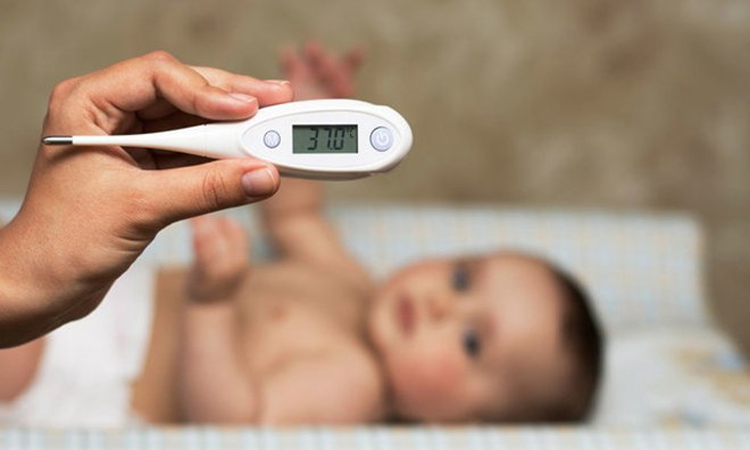
If the child’s temperature is higher than 38.5 degrees Celsius, it is advised to take them to the nearest medical facility and administer fever-reducing medicine.
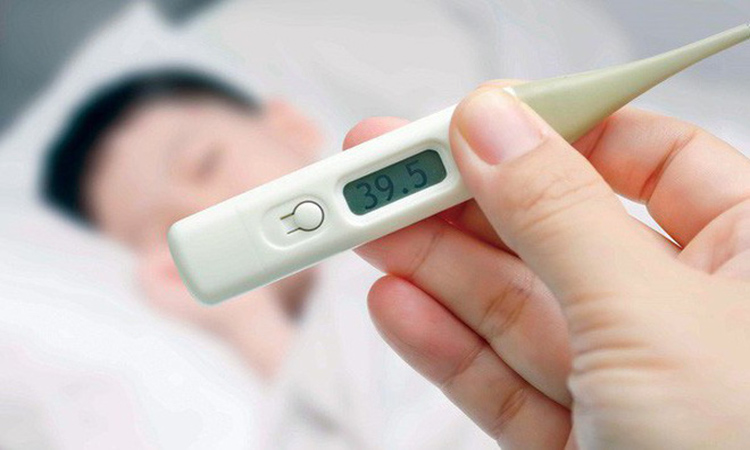
If the temperature drops below 36 degrees Celsius, it is recommended to actively warm the baby using a blanket or through the skin-to-skin method.

To maintain a healthy body temperature, it is recommended that infants’ body temperature be consistently maintained at 36-37°C. Any variation from this range, whether it is an increase of 1°C or a decrease of 1°C, can be extremely hazardous.
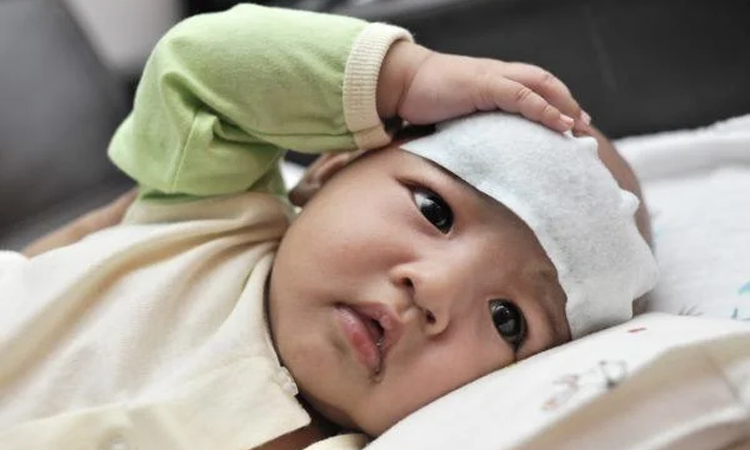
Typically, the temperature measured orally is consistently 0.3 – 0.5°C lower than the anal temperature. Similarly, the temperature recorded in the armpit and neck areas is consistently 0.3 – 0.5°C lower than the oral temperature.
Essential Advice for Caring for Children with a Fever
Fever can pose a heightened risk of dehydration in children, necessitating an adequate intake of fluids. Appropriate fluids, including milk and water, should be administered to meet the child’s hydration needs. Should the child display resistance to drinking water or milk, or if there are any concerns, it is advisable for parents to seek guidance from a pediatrician.
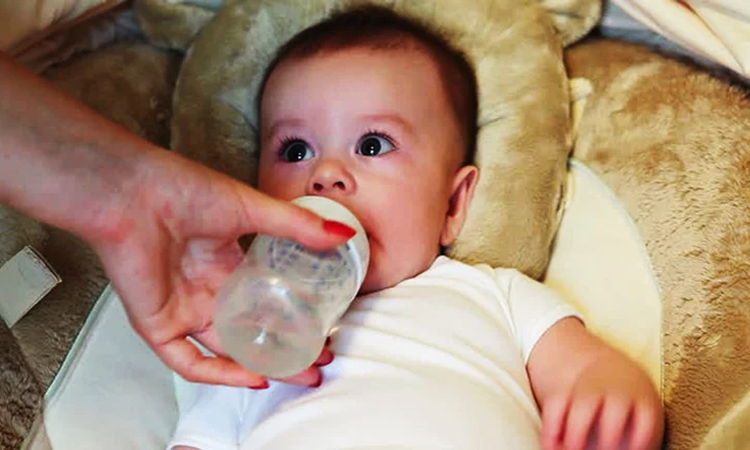
Emphasize the importance of incorporating nutritious foods into your baby’s diet. It is recommended to divide their meals into several smaller portions throughout the day, while also ensuring they are given plenty of fruits and vegetables to provide essential vitamins. When your baby is experiencing a fever, it is advised to dress them in loose, comfortable clothing rather than warm garments.

Fever can greatly impact a child’s well-being, resulting in fatigue and discomfort. As responsible parents, it is essential to prioritize their rest and recovery. Once their temperature returns to normal, children can safely resume their daily routines, including school and other activities, after a 24-hour period.

It is advisable to promptly return to the doctor if the child does not have a fever within 48 hours of starting treatment or if the condition worsens.
When measuring a child’s body temperature, if it is found to be abnormally high or if the fever is accompanied by unusual symptoms such as convulsions or rashes, it is important for parents to promptly take their children to reputable medical care centers for timely examination and treatment.
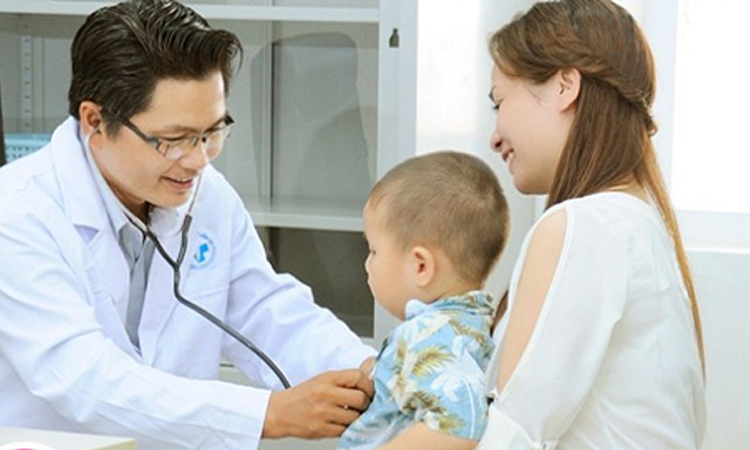
Reference: MSN
The body temperature of a newborn differs from that of an adult, demanding caregivers to be vigilant in monitoring the child’s temperature daily to ensure the utmost care is provided.
Please refer to the website vimec for more information on reference and synthesis.
The post https://meo.tips/how-to/handling-different-fever-temperatures-in-babies/ appeared first on Meo.tips.
View more from Meo.tips:
7 Reusable Household Items You Might Be TossingProven Tactics for Drying Wet Sports Shoes Quickly and Efficiently
Understand Energy-Saving Labels When Shopping for Energy-Efficient Products
The Risk of Underestimating Getting Caught in the Rain
What Are the Benefits of Soaking Your Feet in Hot Water?
7 Tips to Collect Debt Gracefully During the Tet Holiday
Has the CEO of Levi’s Not Washed Jeans in 10 Years? How Often Does He?
Uncovering the Unexpected Uses of Anise Soaked in White Vinegar
3 DIY Hair Masks to Nourish Dry, Tangled Hair
Which Fan Size is More Energy Efficient?
Understanding the Significance of Symbols on Clothing Labels
Strategies to Keep Flies, Ants, Cockroaches, and Other Indoor Insects Away
Home Remedies for Removing Dark Circles Under Eyes
Dangerous Foods to be Aware Of
Create Spectacular Handmade 3D Cards for International Women’s Day!
Surprising Method to Repurpose Used Cosmetics
7 Tips to Minimize Pores and Reduce Oily Skin During the Summer
Six Essential Guidelines For Selecting and Applying Perfume
Here’s a Guide to Easily Verify Product Barcodes with Your Phone
The Often Overlooked Kitchen Essential: Dish Towels
Nhận xét
Đăng nhận xét